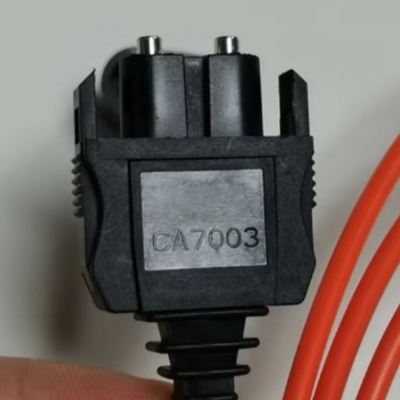



HPCS (High-Performance Cable Assembly) is an industry-wide identifier for high-performance fiber optic patch cords, which usually includes the following key features:
Reinforced structural design: higher mechanical strength and environmental adaptability than standard patch cords
Precision optical performance: meets data center/telecom-grade transmission requirements
Models:
CF-1071 Fiber Optic Patch Cord
CA7003-200/230UM Fiber Optic Patch Cord
CA7103-200/230UM Fiber Optic Patch Cord
CA9003 Fiber Optic Patch Cord
Jinzhi provides a series of plastic optical fiber products in the domain network. Plastic optical fiber has been used in industrial control for more than 10 years. Due to its excellent electrical "noise" immunity, it is widely used in fieldbus, process control and digital control in industrial control. Many factory internal control networks connect controllers, equipment and sensors to monitor data and provide simple control feedback to the production line.
The core material of HPCS fiber optic patch cord is composed of fiber core and cladding + coating + sheath + connector components. Its high-speed transmission can meet the needs of most users for large-capacity data transmission and other functions. It is the only choice for many customers to repurchase!
Product standards:
Passed ISO/IEC, TIA/EIA and other certifications, compatible with mainstream manufacturers' equipment (such as Cisco, Huawei).
Outstanding features:
1. High performance
Low loss: Optimize the fiber core process to ensure efficient and stable signal transmission
2. High reliability
Durable material: The armored design is anti-extrusion and anti-pulling, suitable for complex wiring environments.
Strict testing: OTDR detection before leaving the factory to ensure low insertion loss and return loss.
3. Flexible adaptation
Multi-type interface: LC/SC/MPO and other mainstream connectors are optional, compatible with various optical modules and devices.
Multi-mode/single-mode optional: support short-distance and long-distance transmission requirements.
4. Environmental adaptability
High temperature resistance/anti-interference: Some models support -40℃~85℃ operating temperature, and the armored model is resistant to electromagnetic interference.
Typical application scenarios:
1. Fiber optic communication system
2. Enterprise network
3. Fiber to the home
4. Medical equipment and instruments
5. High-definition audio and video transmission
CA7003 Signal Connector
Name: CA7003 Signal Connector
Model: CA7003
Brand: Mitsubishi
Compatible Models: Mitsubishi MR-J4 Series Servo Drives
Product Standard: Compliant with IEC 61076-2-101
Connector Type: 24-pin high-density plug
Connector Material: PA66 flame-retardant engineering plastic (housing), gold-plated copper alloy (terminals)
Technical Parameters: Rated Current 3A, Rated Voltage 250V

CA7103 Fiber Optic Connector
Name: CA7103 Fiber Optic Connector
Model: CA7103
Brand: Compatible with Mitsubishi and other CNC equipment
Compatible Models: Fully compatible with Mitsubishi Q-series PLC modules, DL6-CP, DL-72ME, and other fiber optic connectors. Compatible with various fiber optic specifications, including 50/125μm, 62.5/125μm, and 200/230μm.
Product Standards: Utilizes fiber optic connectors and H-PCF cables that comply with the Japanese JIS F06 standard, introduced in 1998 and widely used for optical data communication between PLCs, machining centers, and other mechanical equipment.

CA9003 Fiber Optic Connector
Name: CA9003 Fiber Optic Patch Cable
Model: CA9003
Brand: HITACHI. Many compatible brands are also available on the market.
Compatible Models: Compatible with Toshiba's Toslink F05 universal optical link transceivers, suitable for Mitsubishi MELSECNET/10/H networks and PLC communications. Compatible with numerous modules, including the DL-72 and DL6-CP.
Product Standards: Utilizes fiber and connectors that meet industry standards, ensuring stable and reliable data transmission.

Why choose KINZ-HPCS fiber jumper?
1. Suitable for short-distance high-speed communication. It has a large core diameter and is easy for users to connect
2. High coupling efficiency, good flexibility and light weight
3. Strong anti-electromagnetic interference ability, able to achieve stable transmission.
The steps for using this series of products are simple. The core is to complete the optical signal connection between devices:
1. Confirm the fiber interface type of the devices at both ends and match it with the jumper connector;
2. Clean the jumper connector and the device interface;
3. Align the interface and insert the connector. The connection is complete when you hear a "click" sound or feel it in place;
4. Check the device optical signal indicator to confirm that the transmission is normal;
5. When disassembling, pinch the connector shell to plug and unplug to avoid pulling the cable.
During use, you need to handle it with care to avoid excessive pulling and damage to the quality of the optical fiber.
Secondly, you can clean the connector end face regularly to ensure the cleanliness of the end face.
If you have any questions, please contact us and we are always here to answer you!
Problems and solutions that may be encountered during use
1. When the jumper is overheated or damaged, ensure good heat dissipation and avoid long-term full-load operation
2. When the connector cannot be inserted, please confirm the device interface type first, then replace the correct jumper or use a converter
3. When the signal is attenuated or even interrupted, use a fiber optic microscope to check the specific situation, then use a dust-free cotton swab to clean the end face to check whether it exceeds the bending radius of the optical fiber
4. When the optical module recognition error is displayed, first check the wavelength of the optical module, and then replace the matching jumper